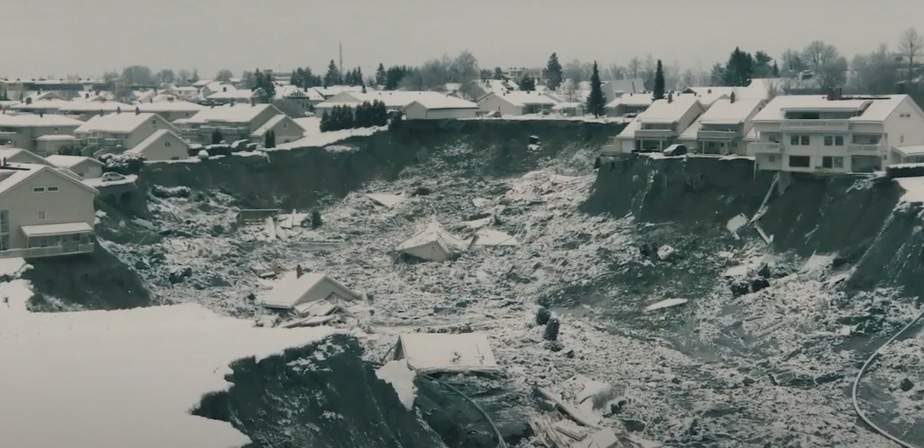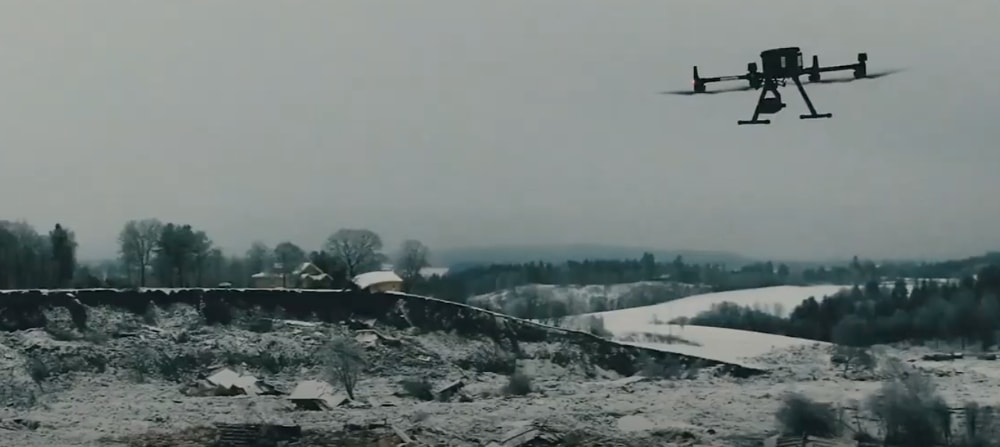Landslide in Norway Leads to Largest European Drone Operation Ever, 200+ Hours of Flight Time Recorded
BY Zacc Dukowitz
17 February 2021A recent landslide in the village of Ask, Norway led to the largest drone operation that has ever taken place in Europe.
Using a combination of drones and helicopters, emergency responders conducted a total of 420 missions looking for landslide victims over a period of several weeks, logging over 200 hours of flight time in the effort.

Some of the damage caused by the landslide in Ask
About the Landslide
The giant quick clay landslide hit the village of Ask at four in the morning on December 30th, 2020. It was 900 feet wide and 2,000 feet long at the time of impact, and it would ultimately grow to cover over 124 square miles.
In the first few hours after the landslide hit, first responders helped locate and rescue 13 people from collapsed houses throughout the town.
The landslide continued to move through the area as emergency personnel worked to remove people from the rubble. Over 1,000 people were evacuated over the next few days.
In total, the landslide destroyed 31 homes and killed seven people. Three more people are still missing.
How the Rescue Operation Unfolded
In the first hour after the landslide the police flew a helicopter over the area, assessing the damage and looking for people who might be trapped in their homes.
Shortly after that, police tried launching a drone to support aerial search and rescue efforts, but it had to be taken down due to harsh weather.
More drones and helicopters arrived to help throughout the morning, along with troves of first responders and volunteers. Before long the airspace surrounding Ask was turned into a temporary no-fly zone, restricted to use only by those officially supporting rescue efforts.
As the operation in Ask unfolded it quickly developed in complexity. Here’s a list of all the different groups that supported rescue operations:
- Soldiers from Norway’s elite task force Derby
- 30 search teams with dogs
- Rescue teams from the Oslo Fire Department
- Local fire crews
- The National Brigade of Norway
- The Swedish USAR special crew
And here’s a list of the different vehicles used:
- Several drones equipped with thermal cameras, provided by both police and fire departments (DJI’s Matrice 300 RTK was reportedly one of the models used)
- Lockheed’s P-3 Orion surveillance aircraft
- At least four helicopters
- 25 ambulances
Intensive rescue efforts took place over a period of two days, with helicopters and drones constantly surveying the area for survivors.
During this time, emergency personnel were not allowed to try entering any of the collapsed homes to look for survivors because it was deemed too dangerous.
However, by the third day a few houses were determined safe enough to enter. Laying bright orange Styrofoam boards across the unstable mud, an elite specialist team from Sweden was able to begin entering the homes to continue the search for landslide victims.
That same day, rescuers also began preparing to use a giant army vehicle called a “paver,” which has a giant steel bridge that could allow them to cross wide sections of mud and debris.
Given the instability of the ground, rescuers had to stop their efforts to find people when the day grew dark. But drone operators continued searching throughout the night, using thermal cameras to try and locate survivors.
Managing the Complexity of Aerial Support
Throughout rescue operations in Ask, drones provided an effective tool to look for people trapped by the landslide.
The basic flow rescue personnel followed was to use drones to find and keep watch over landslide victims, and then use helicopters to fly in and rescue them.


Using both visual and thermal data, drone operators flew over the debris caused by the landslide, scanning carefully for signs of movement or a thermal signature that might indicate the presence of a person or an animal in need of help. (In addition to the many people rescued, a missing Dalmatian was found and rescued on the second day of the operation.)
The drones also helped first responders grasp the massive scope of the damage that had been done by the landslide.
When we arrived, the situation was complex and difficult to grasp. But when we got our first drone up, we started to understand the scope of the catastrophe.
– Kenny Åserud, Drone Pilot with Nedre Romerike Fire and Rescue
Drone operators involved in the rescue efforts included fire and police department personnel, military personnel, and one volunteer civilian pilot.
Given the number of drones and helicopters in the air supporting rescue operations communication was essential to avoid collisions.
Those in charge of aerial operations say that they managed the aerial congestion orally and by watching the skies while in flight.
The controlling of the drone resources were done old-fashioned and orally by standing next to each other overlooking the sunken landslide area.
– Jørgen Lunde Ronge, Drone Project Manager for the Norwegian police
Following the initial rescue effort drones continued to patrol the area around Ask for weeks, presumably looking for those who remain missing.
Know of other large-scale drone rescue operations? Share what you know in this thread on the UAV Coach community forum.


